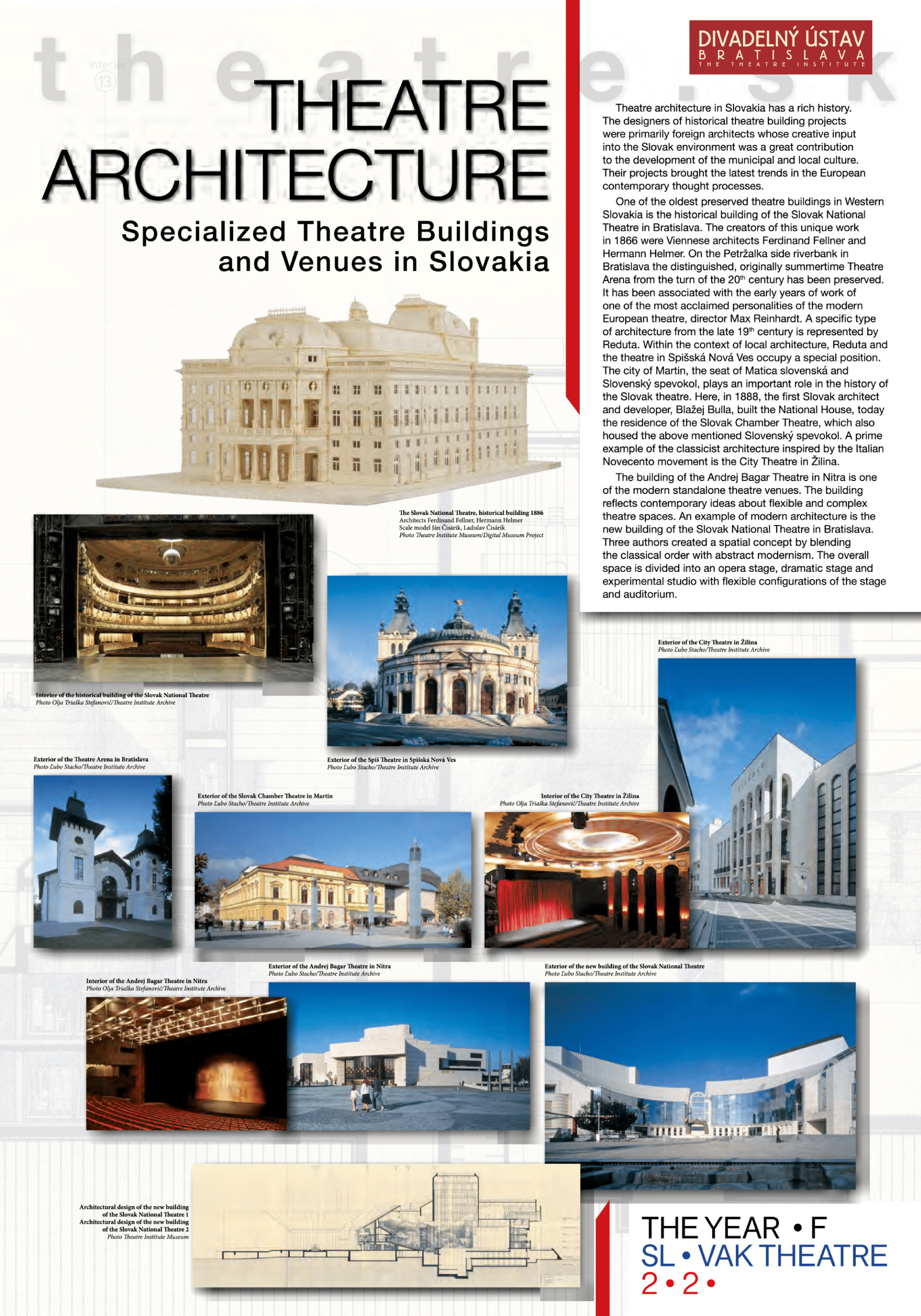
The History of Slovak Theatre – 4. Theatre Architecture
Theatre architecture in Slovakia has a rich hsitory. The designers of historical theatre building projects were primarily foreign architects whose creative input into the Slovak environment was a great contribution to the development of the municipal and local culture. Their projects brought the latest trends in the European contemporary thought processes.
One of the oldest preserved theatre buildings in Western Slovakia is the historical building of the Slovak National Theatre in Bratislava. The creators of this unique work in 1866 were Viennese architects Ferdinand Fellner and Hermann Helmer. On the Petržalka side riverbank in Bratislava the distinguished, originally summertime Theatre Arena from the turn of the 20th century has been preserved. It has been associated with the early years of work of one of the most acclaimed personalities of the modern European theatre, director Max Reinhardt. A specific type of architecture from the late 19th century is represented by Reduta. Within the context of local architecture, Reduta and the theatre in Spišská Nová Ves occupy a special position. The city of Martin, the seat of Matica slovenská and Slovenský spevokol, plays an important role in the history of the Slovak theatre. Here, in 1888, the first Slovak architect and developer, Blažej Bulla, built the National House, today the residence of the Slovak Chamber Theatre, which also housed the above mentioned Slovenský spevokol. A prime example of the classicist architecture inspired by the Italian Novecento movement is the City Theatre in Žilina.
The building of the Andrej Bagar Theatre in Nitra is one of the modern standalone theatre venues. The building reflects contemporary ideas about flexible and complex theatre spaces. An example of modern architecture is the new building of the Slovak National Theatre in Bratislava. Three authors created a spatial concept by blending the classical orger with abstract modernism. The overall space is divided into an opera stage, dramatic stage and experimental studio with flexible configurations of the stage and auditorium.
Multifunctional and Experimental Spaces
From the early 20th century, specialized theatre venues were built as a part of administrative or other functional buildings. The Pavol Országh Hviezdoslav City Theatre is located in the former building of the Slovak National Bank. It was incorporated into a multifunctional building that housed various businesses and operations. The effort to come out of the shadows of the large “stone” buildings is associated with the 1960s and the aspiration to come closer to the spectator. The atmosphere of the 1960s brought unconventional theatre venues where the theatre operation adjusted to other different spaces. For instance, the space of today’s Studio L+S has been a part of the Tatra Hotel from the time of its establishment and the operation of the Tatra Cabaret.
All puppet theatres in Slovakia came into existence by adapting the spaces that were originally used for other purposes. The Žilina Puppet Theatre currently uses the space of the former Jewish gym club Makabi. The Puppet Theatre At the Crossroads has been using the space of one of the houses within a city duplex in Banská Bystrica built in the early 20th century. The auditorium is flexible and can be configured into different patterns. In 2010, the Dance Studio Theatre in Banská Bystrica moved from a smaller space within the house of culture to a renovated building of a former construction and engineering high school.
The architectural experiment Žilina-Záriečie Station – S2 was created as a multifunctional space in 2009. It was built from beer crates and it included a 12-meter long old shipping container. Unfortunately, this venue festooned with many awards burned down in 2019. In 2008, the spaces used by the Teatro Tatro theatre, a tent and a trailer, were supplemented with a new dramatic vehicle and a successful project the Magical Theatrical Vending Machine. It had a world premiere at Cultural Olympics in Canada in 2010.
This is an online version of exhibition theatre.sk.



